Sewerage ventilation in a private house: schemes and design rules
Private houses built taking into account modern projects, as a rule, are equipped with a sewage system. This system is designed to play an important role - to radically improve the sanitary and epidemiological situation inside the premises. However, in the framework of the implementation of such projects, it is also desirable ventilation of the sewer in a private house.
It is projects with the ventilation of sewage systems that guarantee full comfort of the home and contribute to the normal operation of the lines of domestic sewage. What ventilation schemes are most effective and how to implement them in a private house - this is what we will talk about in our article.
We also analyze the installation features of the constituent elements of sewer ventilation, paying attention to the norms and rules that must be observed at the same time.
The content of the article:
Private House Sewerage Device
Private residential buildings, unlike municipal housing, have individual characteristics. Therefore, the sewerage scheme of a private house is not always possible to compare with standard municipal projects. You can only borrow individual solutions.
City municipal real estate is necessarily equipped with internal sewerage with ventilation. Private housing projects often preclude such an approach.
As a result, an important function of the operation of the sewerage is disrupted - blocking the exit of sewer fumes to the interior of the premises.
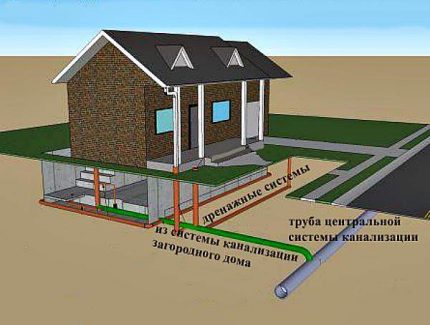
The issue of ventilation of sewer networks is considered, as a rule, in relation to internal communications. This includes all effluent lines mounted directly inside buildings.
In this case, based on the classification of collected runoff water, sewer systems are divided into three types:
- household (economic and fecal);
- rain (rain showers);
- production (industrial).
Household economic and fecal communications, in turn, are divided into centralized and autonomous systems. Many private house projects have been completed and are being carried out under an autonomous type.
True, at the present stage of the construction of private residential real estate, its owners are increasingly trying to connect home sewers to centralized lines. We recommend that you familiarize yourself with all the schemes of local sewerage of a country house, popular among users.
Domestic utilities traditionally contain the following plumbing fixtures:
- sinks and bathtubs;
- toilet bowls, urinals and bidets;
- shower cabins.
This whole set is united by a piping system, which also includes ventilation risers, collectors, pipelines, check valves and other components designed to provide the full functionality of the internal sewage system.
Why do we need sewage ventilation?
According to existing building regulations, low-rise (up to 2 floors) private real estate can be operated without equipping the sewage system with a fan pipe.
This tolerance is due to a small number of people (consumers) living in small private houses, which means a relatively low load on the plumbing.
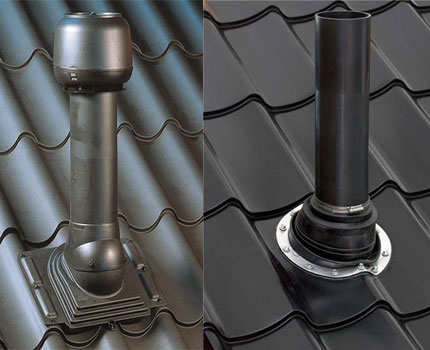
A fan pipe is a structure assembled from standard plumbing pipes and installed as a vertical riser with access to a level above the roof horizon. The purpose of such a structure is to create a connection (ventilation) between the internal atmosphere of sewer communications and the atmosphere of the external environment.
Thanks to this connection, the pressure difference that occurs during the discharge of a large mass of wastewater is compensated. In addition, the ventilation riser eliminates the formation of gas stagnation in the line.
The need to withdraw the ventilation riser becomes apparent if the calculations show that the simultaneous flow from several plumbing fixtures can block the cross section of the main sewer pipe.
This situation leads to a “breakdown” of hydraulic locks (entrainment of water from siphons of sinks, bathtubs, etc.). As a result, unpleasant odors begin to penetrate into the room through the vacant space.
True, for the restoration of hydraulic locks, it is enough for a short time to turn on the spill of water on plumbing fixtures.
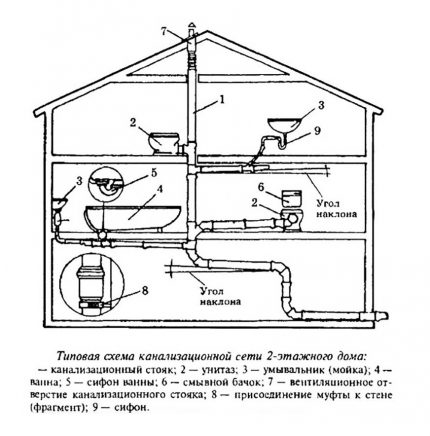
Such a development of events usually does not threaten the communications of a small private house. Nevertheless, it is recommended not to abandon the construction of sewer ventilation for greater reliability and peace of mind for personal comfort.
The introduction of a fan pipe into the sewerage scheme eliminates the “breakdown” of hydraulic locks, provides a balance of air flows and ventilation inside the communications.
Mandatory use of ventilation riser:
- in private houses of more than two floors with the placement of toilets and bathtubs on each floor;
- when the cross-sectional size of pipelines, branches and risers of the sewer line is less than 50 mm;
- The project of the house involves the installation of a septic tank in the surrounding area.
If the project of the house provides for the placement of a pool associated with a common sewage system, you will also have to take care of installing a riser.
Effective ventilation schemes
Consider the main options for arranging effective ventilation of the sewer system in a private home.
Option # 1 - installation of a fan pipe
The efficiency of ventilation of the sewage system is ensured by observing two main principles for installing the fan pipe. The first principle is based on the difference in diameters of the outlet and main pipes.
The diameter of the fan pipe should always be equal to or slightly larger with respect to the diameter of the outlet from the main sewage line.
The second principle is to bring out and mount the output of the upper end part of the ventilation pipeline into the free air flow zone.
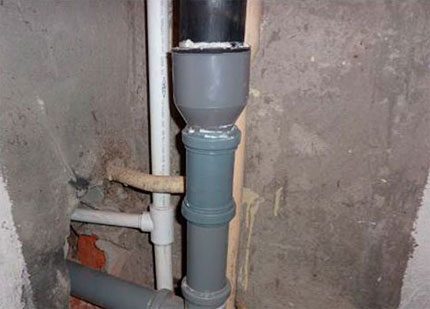
The installation of the ventilation riser is traditionally carried out using standard plastic pipes with a diameter of 110 mm. In addition to plastic, cast-iron pipes are also used to assemble the fan line. But such a construction option, as a rule, is the prerogative of large projects.
Pipes are connected to one another using rubber seals. They fix the ventilation line to the wall of the house with metal clamps, laying them on the surface of the pipes through rubber gaskets.
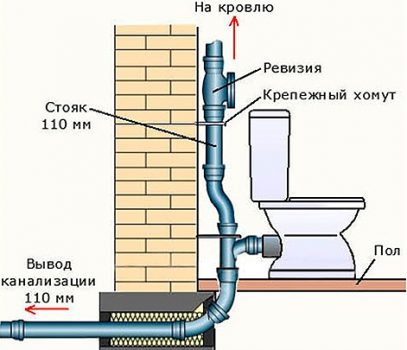
The upper point of the vented ventilation pipe should be above the roofing horizon of at least 300 - 700 mm. These values are recommended for installation on houses with flat roofs or where the roof is made under a slight slope. The steeper the roof slope, the higher the height of the end part of the ventilation pipe.
Building codes also provide for maintaining a height distance from the top of closely spaced windows to the top of the fan pipe.
Here it is recommended to adhere to parameters not less than values equal to 3.5 - 4 m. Ventilation of the home sewage system is mounted as a separate communications node.
Rules (SNiP) do not allow combining sewer ventilation lines with other technical systems (chimneys, air exhausts, etc.).
In developing a project for the construction of ventilation of an independent sewage system in a country house, the following requirements must be taken into account:
We have detailed instructions on the website with step-by-step photos on installation of the fan pipe.
Option # 2 - fan pipe + end pipe
For projects of private houses, it is sometimes permissible to introduce a scheme for installing a ventilation sewer riser, in which the upper section of the pipeline remains in the attic area.
But in this version, the attic should have a design of actively ventilated rooms, which is rare for private housing projects. Therefore, the scheme with pulling the sewer ventilation pipe through the roof of the building remains relevant.
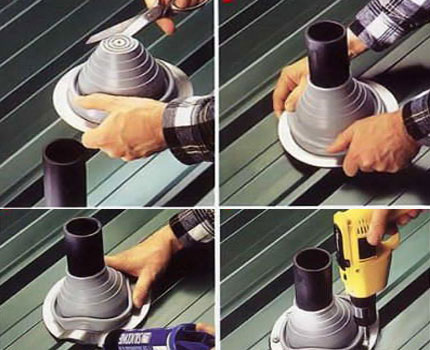
The conclusion through the roof is usually implemented according to the following plan:
- Vent riser finish in the attic.
- An end pipe is installed on the roof.
- Corrugate the upper section of the riser with the lower section of the trailer.
It is convenient and simple to install the end pipe on the roof using an elastic polymer adapter. This durable durable element has a round shape (there are also square ones), and due to the stepwise change in the diameter of the passage, it is easy to fit it to a pipe of a particular section.
It is only necessary to cut off the excess part of the adapter material along the line of the required diameter.
The end pipe, equipped with an adapter, is inserted into the passage hole previously made in the calculated place of the roofing.The lower cuff of the elastic adapter over the entire circumference of its abutment is treated with sealant.
Then, using a metal flange and screws, the cuff is tightly fastened to the roof surface.
In order to enhance the efficiency of natural traction, an additional deflector.
Ventilating deflector - a device that can enhance air draft due to the pronounced aerodynamic properties of the structure. The principle of operation of such devices is based on the Bernoulli effect, when the velocity of air masses is directly proportional to the change in the cross section of the channel.
For sewer ventilation schemes of private houses, static (fixed) deflectors are often used. Less commonly used rotary (rotating) deflectors.
This seemingly simple device plays a significant role in the ventilation of a home sewage system. According to various estimates, the deflector gives an increase in traction gain by 20-30%.
Option # 3 - sewer hood device
If the sewer outlet is not equipped with a water lock or the action of the specified useful device is not enough, it is worth constructing and installing a sewer hood:
Option # 4 - installation of aeration (vacuum) valve
The use of vacuum (aeration) valves as an alternative to a fan pipe should be considered a purely conditional phenomenon. The scheme with vacuum valves, the owners of private real estate can only apply if it is completely impossible to install a ventilation riser.
The low reliability of aeration valves is confirmed even by the absence of any information on these devices in the SNiP documentation.
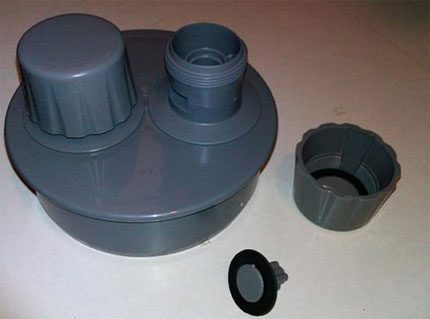
Vacuum valves are used exclusively on sewerage systems of private small-format houses.
Simple valve device:
- plastic round case;
- in the body a through hole for the valve;
- membrane, rubber gasket.
The principle of operation of the device is also simple. If a discharged atmosphere (vacuum) is created in the sewer pipe due to an imbalance in pressure, the valve opens and air from the room is sucked into the pipe. As soon as the pressure in the pipe is equalized, the valve returns to its place.
If desired, the aeration mechanism can be done independently. But there are factory products on sale that have running sections of 50 and 110 mm. They are not cheap, but more reliable.
Aeration valves are usually installed in the immediate vicinity of plumbing risers at the upper points of the sewer system. Most often, the installation of the valve is done on the upper branch of the tee (cross), which is mounted on the drain line from the toilet.
Owners of private houses who have opted for aeration valves will have to periodically engage in the maintenance of these plumbing fixtures.
A certain period of operation of vacuum valves is accompanied by the accumulation of deposits and contaminants in the place where the valve seal is located.
The tightness of the device is broken, the smells of sewers begin to penetrate the room. Therefore, from time to time, maintenance is necessary, and here is another plus in favor of the first ventilation scheme.
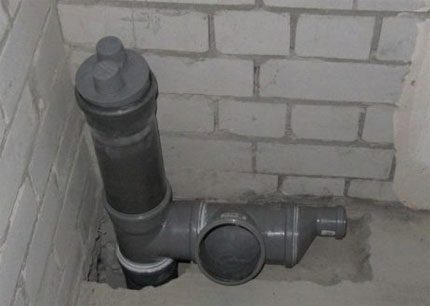
Another disadvantage of simplified valve ventilation of a domestic sewage system is that it is functional only in conditions of positive temperatures. That is, if the aeration valve is installed in the area of a possible decrease in temperature to zero degrees or lower, there is a risk of a malfunction of the system.
We have detailed instructions on the website installing a vacuum valve to the sewer.
Option # 5 - outdoor sewage ventilation device
Often there is information on schemes of external ventilation of the sewage system of private houses. The principle of building external ventilation is indicated almost the same as in the case of the internal circuit.
The fan riser for ventilation is mounted against the wall of the house and rises above the roof. Meanwhile, SNiP on this subject do not give any recommendations.
On the contrary, the documentation clearly states that fan risers for ventilation of household sewers should be built inside heated rooms.
Assembling a makeshift fan pipe deflector
It is not necessary to buy a ventilation deflector. This thrust pumping mechanism is quite capable of being done independently.
From the tool kit and material you will need the following:
- galvanized metal sheet;
- fasteners (small bolts with nuts or rivets);
- scissors for metal;
- pencil, ruler.
First of all, the lower part of the device is marked - a cone-shaped bell. At the bottom, its diameter should correspond to the diameter of the ventilation riser, and the diameter of the upper part is increased by 10-15% of the lower size.
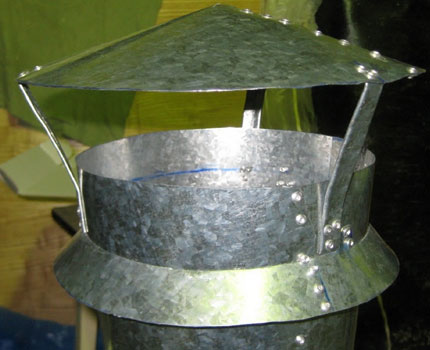
The resulting cone is fastened with bolts or rivets, a “skirt” is placed in the middle part, cutting off part of the air flow. An umbrella is attached to the top of the racks.
Conclusions and useful video on the topic
You can learn more about the location and significance of the fan riser from the following video:
A comfortable home environment is the main factor that encourages owners of private residential buildings to pay attention to standard sewage ventilation technology.
Apply this method or be content with a simplified ventilation scheme - decide directly to the homeowners.Extra plans for the construction of "fly out" a pretty penny. True, you always have to pay for comfort.
Have you thought about installing a ventilation riser for the sewer system of your house? Maybe you still have unclear questions after reading our article? Ask for advice - our engineer will try to help you.
Or are you already using your own simple sewer ventilation? Tell us which scheme you applied, what difficulties you encountered in designing and are you satisfied with the effectiveness of the riser? Leave your comments, add a photo in the block under this article.

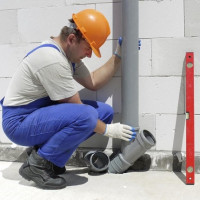 Wiring of sewers in a private house: drawing up a diagram and a project + stages of work
Wiring of sewers in a private house: drawing up a diagram and a project + stages of work 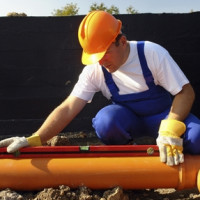 Sewerage device in a country house: arrangement schemes + installation instructions
Sewerage device in a country house: arrangement schemes + installation instructions 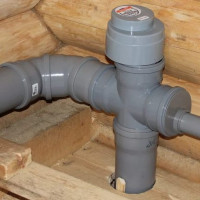 Internal sewerage: device options in an apartment and a private house
Internal sewerage: device options in an apartment and a private house 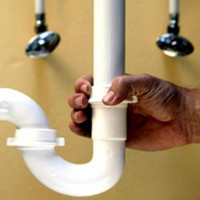 Water lock for sewerage: classification of water locks and the rules for its installation
Water lock for sewerage: classification of water locks and the rules for its installation  An example of calculating sewage slope: formulas and technological standards
An example of calculating sewage slope: formulas and technological standards  How much does it cost to connect gas to a private house: the price of organizing gas supply
How much does it cost to connect gas to a private house: the price of organizing gas supply  The best washing machines with dryer: model rating and customer tips
The best washing machines with dryer: model rating and customer tips  What is the color temperature of light and the nuances of choosing the temperature of the lamps to suit your needs
What is the color temperature of light and the nuances of choosing the temperature of the lamps to suit your needs  Replacement of a geyser in an apartment: replacement paperwork + basic norms and requirements
Replacement of a geyser in an apartment: replacement paperwork + basic norms and requirements